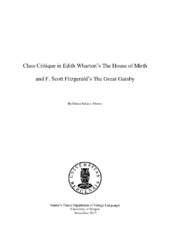Class Critique in Edith Wharton's The House of Mirth and F. Scott Fitzgerald's The Great Gatsby
Master thesis
Permanent lenke
https://hdl.handle.net/1956/10765Utgivelsesdato
2015-11-20Metadata
Vis full innførselSamlinger
Sammendrag
My thesis argues that there are significant similarities between the ways that Edith Wharton's The House of Mirth (1905) and F. Scott Fitzgerald's The Great Gatsby (1925) contribute to a critique of prevailing class structures. I will refer to the techniques used by the authors to introduce the complicated relationships money involves and the difficulties met by women in a society in which men rule. Both novels develop a critique of American society at the beginning of the twentieth century, with differences that intervene due to the specific style and originality of the author, as to the period they have been written in and thus the period they have presented in the novels. These two works are a reflection of the society, of the period they are created in and the purpose of my study has been limited to an investigation of the way Edith Wharton and F. Scott Fitzgerald introduce social class and the methods they use to criticize it. Such methods mostly concern the behavior of the characters and the way they relate to each other. Lucrarea de față este o comparație între The House of Mirth și The Great Gatsby și își propune să investigheze în ce măsură se prezintă o critică a claselor sociale în cele două romane. The House of Mirth a fost publicată în anul 1905, iar The Great Gatsby în 1925, contextul istoric al celor două prezentând diferențe semnificative. Edith Wharton și F. Scott Fitzgerald creează în romanele sale o societate în care comportamentul claselor sociale este demascat, o realitate în care personajele sunt expuse ca fiind preocupate doar de propriile interese. Studiul este împărțit în două capitole: primul capitol stabilește care sunt asemănările dintre tehnicile celor doi scriitori de a introduce o critică de clasă prin intermediul banilor, iar al doilea observă modul prin care sunt construite personajele feminine astfel încât să devină niște instrumente pentru naratori în scopul creării criticii de clasă.
